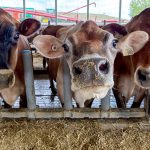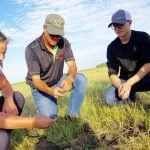Programs that once focused primarily on production factors now also pay attention to how animals are treated
RED DEER — A state of the art hog barn may not be a guarantee of good animal welfare.
“You can have very good facilities, but the animals can be managed in a way that the quality of the facility has nothing to do with the state of the animal or what the animal is experiencing,” says animal welfare specialist Ed Pajor of the University of Calgary’s faculty of veterinary medicine.
Many quality assurance programs are adding welfare assessments to focus on the animal’s well being rather than the production system, he told a hog technology workshop in Red Deer Oct. 21
Read Also

Forecast leans toward cooling trend
July saw below average temperatures, August came in with near to slightly above average temperatures and September built on this warming trend with well above average temperatures for the month.
Animal welfare assessments vary from voluntary codes and guidelines to regulated programs. Some are in response to the demands of specific corporations and their way of differentiating products and labelling.
Canada has had codes of practice for the humane handling of livestock since 1984, and most have been revised in recent years. More commodity groups are adopting mandatory standards based on the codes.
“Standards are science based today,” he said.
“There has been enough science done in a number of different areas to be able to say there are some general principles involved when it comes to developing animal welfare standards.”
Animal care became part of the Canadian Pork Quality Assurance Program in 2012.
A new code of practice was released last year, so a new welfare assessment for the assurance program will be launched in 2017 to fit with new requirements and recommendations.
“You can’t have a code of practice without having the assessment in place,” Pajor said.
“It needs to reflect the requirements and recommendations within the code.”
The National Farm Animal Care Council has developed an animal care assessment framework so that all livestock groups have the same process when creating on farm animal welfare assessments.
There are three types of assessments:
- Self-assessment: Producers audit their own operations.
- Second party audit: Producers use a paid consultant such as a veterinarian.
- Third party auditor: This is the gold standard, in which the auditor has no conflict of interest or financial relationship with the farm.
Most organizations and consumers want the third party assessment. The audit is a formal evaluation with standards and results to benchmark for future improvement as well as identify areas for more education.
The hog assessment has historically focused on the design of buildings and engineering requirements but less on animal based criteria. It is easy to measure and thought to be more objective than observing behaviour.
“They are important because they do describe risk factors that can affect animal welfare,” he said.
Resource based measures were thought to be easier to do, but producers with older operations might score lower because the design specifications have changed. However, they may provide excellent care for their animals by making accommodations in the structure of the barn.
“Once you build a facility and put certain sized pens in place and certain floors, you are kind of stuck with that based on the economic factors involved,” Pajor said.
Other countries are incorporating animal based criteria into new assessment programs, which look at the behaviour and incidence of illness or injuries.
“Animal based measures really represent a significant shift in how we think about on-farm animal welfare assessments,” he said.
More responsibility falls on the producer because it reflects what happens in the barn on a daily basis. Producers are usually the first to notice when animals are not well because they are too cold, too hot, injured or sick.
The public also expects farm animals to be treated well.
“I am convinced we are not going to have less interest in animal welfare,” Pajor said.
“Demands from the public are going to keep increasing.”
A Canadian consumer survey from last year showed a strong preference for farm animals to live in natural environments. They are opposed to confinement and prefer small family farms.
A recent Gallup poll in the United States found that 32 percent of people believe animals have the same rights as people. This is up from a 2008 survey when 25 percent said animals have rights.
The European Commission is about to launch the Eurobarometer survey on animal welfare. The last one took place in 2007 and had a big impact on how policy was developed in the European Union.
barbara.duckworth@producer.com















